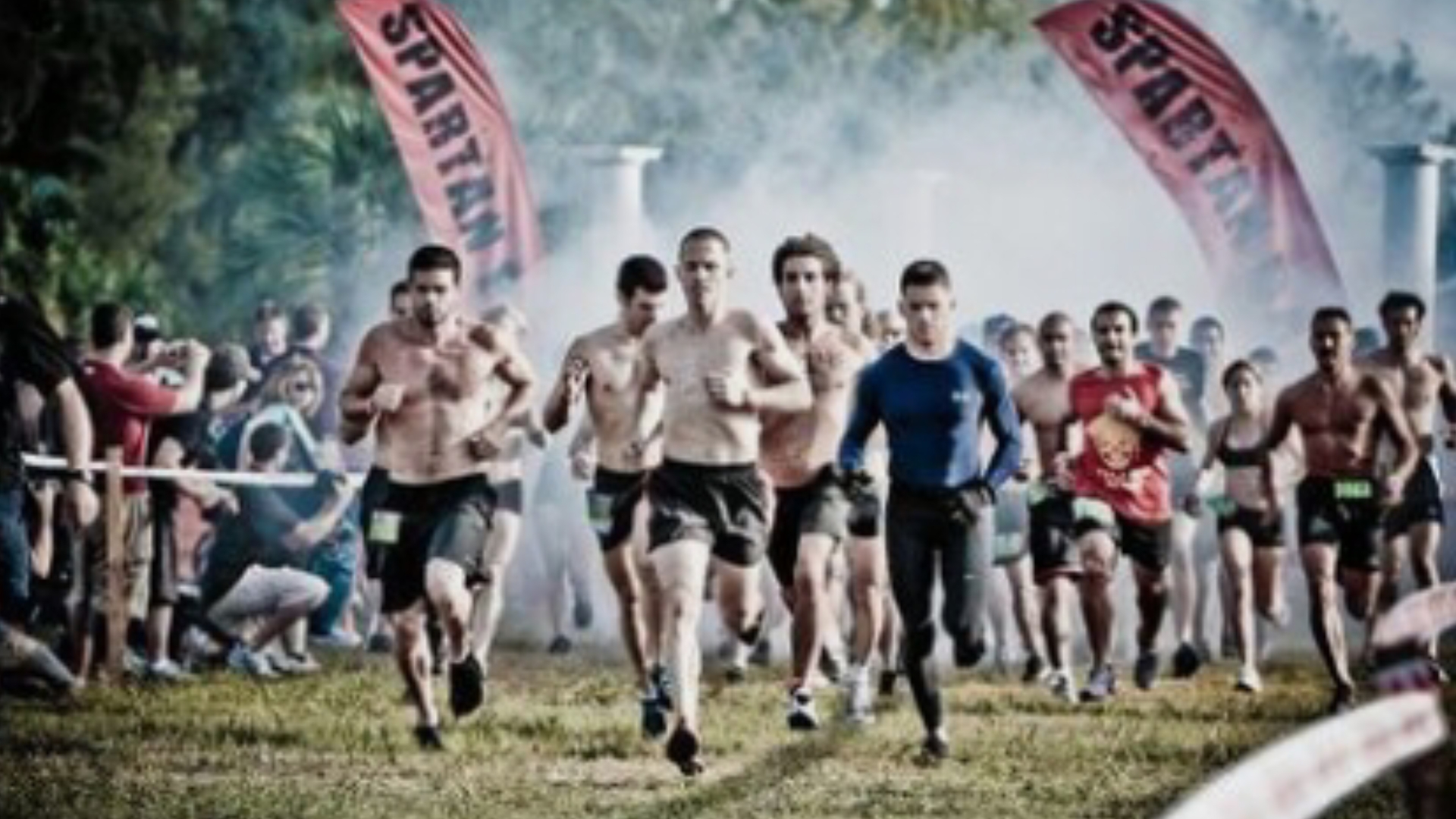
Anthony Crilly leads pack in 5000 meter race.
Legendary American mountaineer Jim Whittaker once said, “If you’re not living a life on the edge you’re taking up too much space! You learn the most when you’re out of your comfort zone!” This is great wisdom because I learn the most when I’m out of my comfort zone! That’s 5K training at its best! As things go to master the 5K, I know I can’t just run distance, goal-pace intervals and a tempo run or two. Instead, I have to schedule workouts that target every aspect of my running fitness.
What I have been learning from elite runners, a fast 5K requires the speed and strength of a miler combined with the endurance of a marathoner. I am achieving that by performing a wide variety of fast-paced workouts. Some that have certainly taken me outside my comfort zone. The result have been an upgrade in my all-around running fitness and, recently, a new personal best (PB). In the following article I’ll dissect each piece of my preparation process and explain how it all comes together on the way to my sub 22-minute 5k. I achieved sub 23-minute 5k by beating my PB by :41 seconds to 22:26 in early November of this 2018 year. My success December 15 in running a sub 22- minute 5K has come to fruition.
Developing A Better Sense of Pace
My line between setting a new personal best and a near miss is often razor thin. The lack of experience like running too fast or too slow per mile at any point during a race has changed my primary energy system. It spells disappointment for my personal best attempt. To make the task more difficult, my sense of pace and effort often get thrown off as adrenaline rushes through my body as dozens of runners fly by me and test my ego at the start.
Unfortunately, pacing is not an aspect of my racing I’m not particularly good at. A study found that once recreational running has misjudged my pacing efforts by almost 40 seconds per mile compared to experienced and younger runners, who may be off only off by about 10 seconds per mile.
Given the importance of pacing is an obvious difficulty for me. How do I separate myrself from the pack and train to pace myself like clockwork? Particularly, where does pace training fit into my schedule already packed with threshold workouts, long runs, and VO2max sessions?
How to Improve My Pacing
In order to improve my ability to pace myself, I simply must practice pacing; there are no shortcuts. Learning to pace myrself isn’t going to come easy. I believe its taking countless miles on the road and laps around the track to develop an inherent sense of pace. So, I’m not going to get discouraged if I don’t pick it up right away. I’ll keep working to refine my senses each week and I’ll eventually be my own running metronome to set the tone. In the meantime, I have some tips I practice and workouts that should help speed my process along and in this case worked in teaching my sub 22 -minute 5K goal.
1. Listening to My Body
The first step in becoming a better pacer is by learning to listen to my body and recognizing subtle changes in pace and effort. One of the most effective ways to practice this technique is to listen to my breathing. Once I can lock on to my goal pace for the workout, I cover up my Garmin frontrunner 645 GPS watch and listen to my breathing. Feeling the rhythm in my legs, and noticing the motion of my arms.
If I start to breath slower, faster, deeper or more shallow, I check my pace to see how this breathing change correlates with my speed. Once my workout is finished, I analyze my splits to see if I maintained a consistent pace. In practicing this technique often I start to develop the ability to correlate effort with pace.
2. Develop Pace Workouts
I can also integrate specific workouts into my training schedule that will help me feel the difference between a small change in pace. My two favorite workouts for this are the cutdown run and the alternating tempo run.
During a cutdown run, starting at a specific pace and I try to drop twenty to thirty seconds per mile until the run is finished. Not only has this been a difficult challenge because I’m trying to speed up as fatigue rises, but quickening my pace by only twenty to thirty seconds a mile has been a very slight distinction. Learning to recognize the difference between such paces has helped me to be better able to distinguish between when I unconsciously slow down or speed up during a race. In achieving my two goals i have knocked :40 seconds of those 5K personal bests.
Likewise, the alternating tempo run requires me to switch between half-marathon 9:00 minute per mile pace and a 10K 8:00 minute pace each mile. Constantly slowing down and speeding up throughout my workouts does prevent me from getting in a comfortable zone and challenges my ability to quickly recognize and lock into different paces. This skill is helpful for having to slow down and speed up for course conditions and when I need to push through fatgue in a race situation, which is very rare in a 5k race.
Both of these workouts requires me to continually adjust my sense of pace, which enables me to identify the difference in how my body feels with just a small change in speed. Plus, they are great threshold and lactate clearance workouts, so they won’t detract from my physiological training goals.
3. Run My Race
Once I’ve started to get the hang of pacing in workouts, something changes! This next challenge is learning to do so in a race situation. The first mile of a 5k race is usually a blur and it can be very difficult to keep my wits about me when adrenaline is flowing and I find my goal pace and strive to maintain it the whole race to be above and beyond og goal race finish time.
Implementing specific workouts in my training cycle that I complete at a local road race. Each race is an experience of learning and same distance. My objective is to run my own race ant my own race pace, and striving to beat my previous PB run time. Finding an elite running club where I can learn from other experienced runners and get regimented regular training has attributed to my success in reaching my goals so this training runs schedule becones my normal training runs or threshold workout is implemented in that weekend of the race. On race day, I simply run my intended race like a workout at my goal PB pace. I don’t let the competition or excitement get the best of me and I monitor how different it feels compared to when I’m doing a workout on my own.
4. Terrain
Varying the terrain of my workout can also be an effective way to improve my pacing skills. If I’m having a difficult time controlling my pace in races and workouts,I consider running my workouts on the track. The constant and accurate feedback every 400, 800, 1200, 1600 meters is helpful if I can’t seem to lockdown the right pace and it helps me begin to develop a good feel for pacing.
As I seek experienced runner status, I take my workouts to an unfamiliar road and use my GPS only to tell me when I’ve finished an interval. Absent of familiar visual cues, recognizable hills and turns, and feedback from my watch or running mate(s), I like to add a new challenge to my pacing skills and stimulate development.
5. Confidence
In practicing my pacing skills during each new training segment, I must account for advancing fitness levels, age, and changing courses. The key to recalibrating my sense of pace after advancing in fitness or coming back from fatigue or serious muscle soreness is to give myrself the chance to identify my weaknesses. I avoid jumping into a race without first bringing my sense of pace in line with my current fitness level.
6. Speed and Stride Mechanics
I used to be afraid of the 5k race. I am not an experienced 5k’er an I enjoy being coached at these fast distances. In the 5k, I don’t have time to get my rhythm. Tthe 5K is like getting shot out of a cannon.
It’s true that the 5K requires quickly accelerating to a pace that is 30–60 seconds per mile faster than my T-(threahold) pace. But it’s also true that improving my acceleration and my ability to run comfortably at 5K pace can be easy fixes.
Slow-twitch muscle fibers are associated with endurance, while faster fibers (both intermediate fast-twitch and fast-twitch) give me strength and speed. On distance runs, I rely almost exclusively upon slow-twitch fibers. Even at a 10:00- minute mile pace – marathon pace or 9:00- minute mile pace – half-marathon pace, or even an 8:00- minute mile pace depending on my rapid development, I use very few faster fibers. But when I accelerate off the starting line of a 5K, I use all my muscle fibers—and keep using most of them throughout the race. To use those fibers effectively, I have to properly train them and in doing these below link mentioned exercises I take group exercise classes; Cardio 360, Body Pump, Core Flow, and MXT @MidtownRochester
Once a week—twice if I have time— I perform a short bodyweight or free-weight resistance-training routine classes at Midtown Fitness Club. These exercise classes force my nervous system to recruit all my muscle fibers both simultaneously and explosively, mimicking the demands of the 5K start. This isn’t about building bigger muscles. It’s about teaching my body efficient control of my muscle fibers. Click here for a detailed resistance training class routine example.
7. Strength
I can hold my goal 5K pace for almost the entire 3.1 mile, now. I am hoping to turn back the clock when I ran a 5:00- minute mile in high school and college, but as I push harder and harder, I fall apart. My training includes distance runs, tempo workouts and 400-meter repetitions at my goal race pace or faster. I’m trying to cover all the bases and get better. As I have I’ve broken my sub 22:00- minute 5k race time with a time of 21:40 on December 15, 2018 and now seek to run a sub 20 – minute 5K race. I continue to train the intermediate fast – twitch fibers, the very fibers that are key to maintaining my 5K pace during a race. Intermediate fibers are crucial because they can be trained to provide both the strength and speed of fast-twitch fibers and the endurance of slow-twitch fibers. This is allowing me to run faster for a longer period of time. But achieving this quick trsnsformation requires workouts that specifically target intermediate fibers.
3K-Pace Repetitions Once I accelerate to 5K pace, I need a relaxed stride to maintain it. Since I can’t relax when a pace feels “fast,” I participate with some faster-than-5K training. Workouts at 3K pace—or about 15 seconds per mile faster than 5K pace—has made “slowing down” to 5K pace a more recognizable endeavor. Examples include 200- 400-, 800-, 1200- meter repetitions at 3K pace with at least a 1:1 work-rest ratio between repetitions.
5K- or 10K-Pace Repetitions. Running repetitions at 5K and 10K pace forces my intermediate fibers to produce aerobic energy (the energy source that fuels endurance) at near-maximum levels. A sustained effort at these paces triggers these fibers to physically change in order to produce even more aerobic energy in the future, thus improving my endurance. The catch: sometimes it takes two minutes to reach the critical level of aerobic energy production. So, I have been building up to through a series of repetitions in training that last two minutes or longer, e.g., 6 x 800m @ 5K pace, 5 x 1000m at 5K pace, or 5 x 1 mile @ threhhold pace, with about a 2:1 work-rest ratio between repetitions. These types of repetitions have helped me improve my running economy, the equivalent to a car’s gas mileage. My goal is to run longer and faster than someone else while using the same amount of oxygen. All of the workouts I’m covering in this article build economy, but for 5K-specific economy I’ll want to include some track repetitions at 5K pace, such as those just described.
BONUS: Free Workout Target Paces Table
Hill Repeats The force required to run uphill immediately recruits my intermediate fibers, creating an energy demand in these fibers that far exceeds what my aerobic energy can provide (anaerobic energy, which doesn’t require oxygen, picks up the slack). The result is that hill repeats at 3K effort—not pace, as the grade of the hill usually slows me down—lasting 30–90 seconds trigger two physical changes in these fibers: better strength and increased aerobic energy production. My recovery interval between hill repeats is important. It usually lasts two to three times the duration of the repetition, e.g. 60–90-second recovery for 30-second hill repetitions.
8. Endurance
Of course, the training benefits I’ve discussed are meaningless without a strong endurance foundation for my slow-twitch fibers. I use 100 percent of these fibers continuously during a 5K race, so I need them to be both strong and capable of producing oodles of aerobic energy.
Tempo Runs and Tempo Intervals Just as running faster repetitions at 5K and 10K pace builds aerobic endurance for my intermediate fibers, tempo work does the same for my slow-twitch fibers. “Tempo” is run at an effort that is roughly equivalent to 7:00- minute per mile to 8:00- minute per mile paces. Continuous tempo runs last 20–30 minutes. But they are broken up into 10-minute repetitions with three-minute jog recoveries—that way, I can adjust the pace if it’s too hard.
Distance Runs Distance runs of 30-60-90 minutes at an easy pace strengthen my heart, increase fuel supplies within my muscles, and fortify my muscle fibers and connective tissue (bones, tendons, and fascia). A long run every week of 90 minutes or so will also help boost my aerobic energy production.
BONUS: Free 5K Training Plan
9. Brain Training
The final hurdle to clear isn’t found on the road or in my muscles. It’s my brain. My brain is hardwired to prevent me from damaging my body with a dangerous effort. Therefore, I have to teach it that 5K races are safe. The easiest way to do that? Race a 5K! As a runner, I find that my recent 5K is surprisingly easier and faster than the last, and the reason is largely because I know what to expect. Having felt the discomfort and anxiety that comes with running a 5K hard makes it slightly easier to run another one, as that familiarity (and continued training, of course) breeds confidence to continue pushing outside my comfort zone. As my training progresses and after I’ve raced a couple dozen 5K’s, I hope to acquire the ability to really attack the race, and that’s when my PB will really start to fall, hopefully below the 20:00- minute 5k race goal.
Conclusion.
My goal, now, is to crack a 20:00- minute 5k. I have been running 5k’s and have run over two dozen 5k races in 2018. I have been in the mid-20 minutes or a little lower for my 5k’s. 25:00- minute range. 24:00- minute range, 23:00- minute range, 22:00- minute range, now low 21:00- minute range (race times 23:28, 23:19, 23:10, 23:07, 22:26, 22:46, 21:40), and now want to get to the next level. (See 2018 races .xls) To achieve a 7:00- minute mile pace each mile of the 3.1 miles (5k),
I attribute all my accomplishment of my aforementioned training, wisdom and teachings received from #God and GVH coach Mike Reif, Enhanced Prrformance of Rochester Dr. Rich Wolfe. GVH teammates, runners, and friends. This training article provides all the work-outs, how-to-balance, how to reach my goals, and how to become an elite runner, that I need.
What motivates you to keep pushing to get faster, stronger, better? I hope this inspires you in targeting this race pace: 6:15 minute pace for a sub 20 – minute 5k, will require patience, fortitude perseverance, and everything I gott to run a sub 20 minute 5k. That converts everything I know and don’t to learn, grow, and be strong. Want to run?




